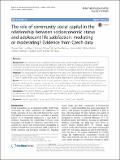Files in this item
The role of community social capital in the relationship between socioeconomic status and adolescent life satisfaction : mediating or moderating? Evidence from Czech data
Item metadata
| dc.contributor.author | Buijs, Thomas | |
| dc.contributor.author | Maes, Lea | |
| dc.contributor.author | Salonna, Ferdinand | |
| dc.contributor.author | Van Damme, Joris | |
| dc.contributor.author | Hublet, Anne | |
| dc.contributor.author | Kebza, Vladimir | |
| dc.contributor.author | Costongs, Caroline | |
| dc.contributor.author | Currie, Candace | |
| dc.contributor.author | De Clercq, Bart | |
| dc.date.accessioned | 2016-12-14T12:30:32Z | |
| dc.date.available | 2016-12-14T12:30:32Z | |
| dc.date.issued | 2016-12-12 | |
| dc.identifier | 248184769 | |
| dc.identifier | 9efeef4d-64d8-43d3-b654-2ab0c5467a10 | |
| dc.identifier | 85003549307 | |
| dc.identifier | 000391406900001 | |
| dc.identifier.citation | Buijs , T , Maes , L , Salonna , F , Van Damme , J , Hublet , A , Kebza , V , Costongs , C , Currie , C & De Clercq , B 2016 , ' The role of community social capital in the relationship between socioeconomic status and adolescent life satisfaction : mediating or moderating? Evidence from Czech data ' , International Journal for Equity in Health , vol. 15 , 203 . https://doi.org/10.1186/s12939-016-0490-x | en |
| dc.identifier.issn | 1475-9276 | |
| dc.identifier.uri | https://hdl.handle.net/10023/9972 | |
| dc.description | This work was supported by the Ministry of Education, Youth and Sports (MEYS) under contracts No. LG14042 and No. LG 14043. | en |
| dc.description.abstract | Background. The concept of social capital has been extensively used to explain the relationship between socioeconomic status (SES) and adolescent health and well-being. Much less is known about the specific mechanism through which social capital impacts the relationship. This paper investigates whether an individual’s perception of community social capital moderates or mediates the association between SES and life satisfaction. Methods. This study employs cross-sectional data from the 2009–2010 Czech Health Behaviour in School-Aged Children survey: a WHO Collaborative Cross-National Study (HBSC). A sample of 4425 adolescents from the 5th, 7th and 9th grade (94.5% school response rate, 87% student response) was used to perform multilevel analysis. Results. We found that pupils’ life satisfaction was positively related to both family affluence and perceived wealth. Moreover, we found the cognitive component of social capital to be positively associated with life satisfaction. Additionally, a significant interaction was found, such that the social gradient in life satisfaction was flattened when pupils reported high levels of perceived community social capital. Conclusions. The present findings suggest that community social capital acts as an unequal health resource for adolescents, but could potentially represent opportunities for public health policy to close the gap in socioeconomic disparities. | |
| dc.format.extent | 12 | |
| dc.format.extent | 614106 | |
| dc.language.iso | eng | |
| dc.relation.ispartof | International Journal for Equity in Health | en |
| dc.subject | Health inequalities | en |
| dc.subject | Social capital | en |
| dc.subject | Life satisfaction | en |
| dc.subject | Youth | en |
| dc.subject | Czech Republic | en |
| dc.subject | RA0421 Public health. Hygiene. Preventive Medicine | en |
| dc.subject | RJ101 Child Health. Child health services | en |
| dc.subject | HM Sociology | en |
| dc.subject | NDAS | en |
| dc.subject | SDG 3 - Good Health and Well-being | en |
| dc.subject.lcc | RA0421 | en |
| dc.subject.lcc | RJ101 | en |
| dc.subject.lcc | HM | en |
| dc.title | The role of community social capital in the relationship between socioeconomic status and adolescent life satisfaction : mediating or moderating? Evidence from Czech data | en |
| dc.type | Journal article | en |
| dc.contributor.institution | University of St Andrews. School of Medicine | en |
| dc.contributor.institution | University of St Andrews. WHO Collaborating Centre for International Child & Adolescent Health Policy | en |
| dc.contributor.institution | University of St Andrews. Child and Adolescent Health Research Unit | en |
| dc.identifier.doi | 10.1186/s12939-016-0490-x | |
| dc.description.status | Peer reviewed | en |
This item appears in the following Collection(s)
Items in the St Andrews Research Repository are protected by copyright, with all rights reserved, unless otherwise indicated.

